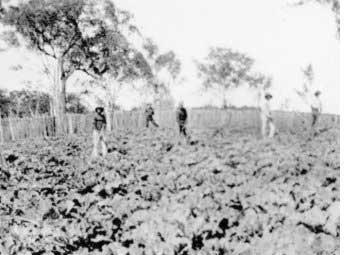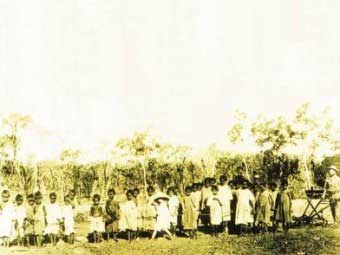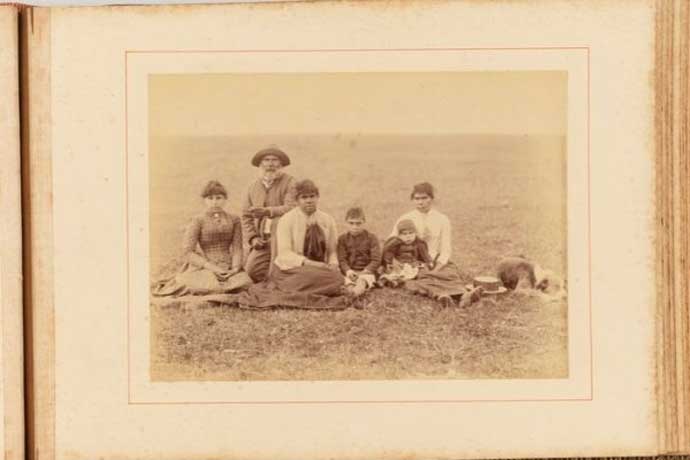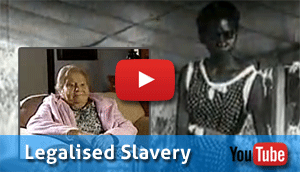Legalised slavery - another hidden reality in Australia's 'proud' history
Felicity Holt is almost 77 years old. She lives in Queensland and remembers the day she was taken away from her parents in Cherbourg. She was just 16 and hopeful of a future in nursing. 'I had enrolled in nursing at the Cherbourg Hospital because I love looking after people, and they came and took me and sent me to St Joseph's Convent in Dalby to work in the kitchen,' Mrs Holt said.
ABC Radio National (RN) Bush Telegraph, presented by Cameron Wilson
10 July 2014
For almost a century, tens of thousands of Indigenous Australians were forced to work for pastoral stations, missions and government reserves for little more than pocket money. Some have called it legalised slavery and are now fighting to recoup stolen wages. Verica Jokic reports.
For almost a century, tens of thousands of First Nations people were forced to work for pastoral stations, missions and government reserves for little more than pocket money. Some have called it legalised slavery and are now fighting to recoup stolen wages. Between the 1860s and the 1970s, Aboriginal people of all ages were taken from their homes and sent to work on cattle and sheep properties all across Australia.
Between the 1860s and the 1970s, Aboriginal people of all ages were taken from their homes and sent to work on cattle and sheep properties all across Australia.
Several such schemes were run by colonial and state governments, theoretically to protect Aboriginal Australians from mistreatment.
People were forcibly sent to work, sometimes far from their homes, where they spent up to 16 hours a day toiling in kitchens, homesteads, shearing sheds or on the land.
Wages were very rarely paid.
Felicity Holt is almost 77 years old. She lives in Queensland and remembers the day she was taken away from her parents in Cherbourg. She was just 16 and hopeful of a future in nursing.
'I had enrolled in nursing at the Cherbourg Hospital because I love looking after people, and they came and took me and sent me to St Joseph's Convent in Dalby to work in the kitchen,' Mrs Holt says.
'I had no say on the settlement. I wanted to finish nursing and it was devastating to be taken away from it.'
Mrs Holt spent more than a year working as a domestic in the convent's kitchen before being sent to one pastoral station and then another.
'I did the washing, cooking, ironing,' she says. 'I was getting up at 5 am to milk the cows and had to separate the milk from the cream.'
'Then I had to cook breakfast, get the kids ready for school, make lunches for the kids, cook the evening meal and prepare things for the following day. By the time I got to bed it was 10 o'clock at night. It was like slave labour.'
For all her work on the pastoral stations, Mrs Holt was given a few coins in pocket money each week. The rest was placed in trust accounts opened by the Queensland government that she and other Aboriginal workers were rarely, if ever, allowed to access.
HISTORIAN AND AUTHOR
Mrs Holt was one of the more fortunate Aboriginal workers and says she was treated well at the pastoral stations and only spent three years working under the protective laws scheme.
Others spent 30 or 40 years working on stations and missions, some until the day they died.
Dr Rosalind Kidd is an historian, author and specialist in Aboriginal affairs. She says from the late 1800s to the early 1900s, colonial and then state governments contracted out Aboriginal men, women and children to work.
'The government saw they were a very useful workforce and the government needed the pastoral industry to succeed.'
'White people would not go there and do the work and there were whole groups of Aboriginal people out there; they brought them under control to work anywhere in the state and with no real protection.'
'It became such an advantage for state governments to do this that they continued to do it.'
According to Dr Kidd, the schemes only ended in 1970.
The laws gave the governments an extraordinary level of control over every aspect of Aboriginal people's lives, including their personal finances, where they lived, where they worked and how much they were paid.
Each colony had its own protective laws. In WA, for example, from 1874 any Aboriginal child could be institutionalised and apprenticed to work from the age of 12 until the age of 21. In 1886 the age a child could be sent to work was lowered.


Images: (left) First Nations children removed from homes and sent to work in missions (Right) Under government watch, First Nations workers in a cabbage garden at Barambah settlement, circa 1912 (Image source: ABC)
Dr Kidd says boys were generally sent to work on pastoral properties, while girls worked as domestic servants. They were given no protection and were often exposed to both physical and sexual abuse.
'Floggings were common,' says Dr Kidd. 'Police would find runaways and send them to Palm Island as punishment.'
Palm Island was so far away from most workers' families that it ensured separation of families.
According to Dr Kidd, some police colluded with business owners to increase prices on goods, to forge witness signatures to withdraw workers' money or to deny them access to their money.
'Sometimes they would tell the Aborigines to come back another day, but some of those Aboriginal people were only able to come into town once a year,' she says.
 Australia's 'Sugar Slaves' remembered
Australia's 'Sugar Slaves' remembered
 Fight for stolen wages with petition to WA Parliament
Fight for stolen wages with petition to WA Parliament
 WA under fire over stolen wages compensation
WA under fire over stolen wages compensation
 Half a billion in Stolen Wages contributed to abject poverty
Half a billion in Stolen Wages contributed to abject poverty
Dr Kidd is one of the few people in Australia who has had open access to Queensland government documents on protective laws and stolen wages. She says there is evidence of long-term failure by governments to protect the wages, pocket money and savings of Aboriginal workers, despite countless warnings that people were being cheated.
'From 1919 the government said pastoral workers would get 66 per cent of the white wage, but records show that in 1949 workers got only 31 per cent,' she says. 'In fact, in every year between 1941 and 1956 the government sold Aboriginal labour for less than the 66 per cent rate.'
'Evidence shows the government itself raided Aboriginal monies: it intercepted federally-paid maternity allowances from 1912 and child endowments from 1941, and paid only a fraction through to the mothers.'
'In the mid 1950s, when infant mortality on government settlements was six times higher than in the white community, the government used child endowment for buildings and machinery.'
Tens of millions of dollars were taken out of the Queensland trusts and never returned to Aboriginal workers.
Mrs Holt is one of the tens of thousands of Indigenous Australians who have been fighting to recoup their stolen wages.
'They built Queensland's hospitals with our money,' Mrs Holt says.
'We've been asking for our stolen wages and have been told our files were deliberately destroyed or our personal files are missing. The community is ropable because they worked hard for the money and it's been stolen from them.'
In 2006, a Senate inquiry was held into stolen wages and recommendations were made for all state and territory governments to make reparations, and to allow access to all files.
However, Dr Kidd says the compensation has been insufficient.
The Queensland government under Peter Beattie fought several cases for compensation, with little success. Thousands lined up for payments, which the government capped at $7000. Mrs Holt was one of those who accepted the offer.
She says the payment came in two instalments: the first when Mr Beatty was Queensland premier and the second under Anna Bligh.
'When I got the first $4,000 I was told I had to sign a paper that I would not take the government to court and I signed because I thought it was better than nothing,' Mrs Holt says.
'I found out I couldn't get the money unless I signed the document.'
Two years later she received the remaining $3,000. 'I don't think I made the right decision,' she says now.
Dr Kidd says the fight for stolen wages is about more than money.
'This is also about truth in our history. The vast majority of non-indigenous Australians have no idea of the enormous debt they owe to the Aboriginal men, women and children whose labour built this country.'
'They have no idea that many workers would have had money and freedom to prosper if governments had not stifled their choices, ignored, unpaid and underpaid [their] labour, and misused their earnings and entitlements.'



